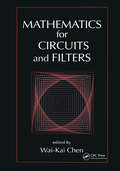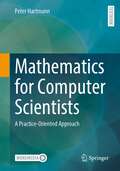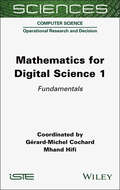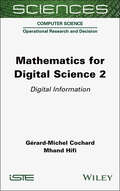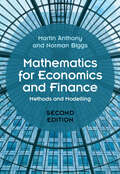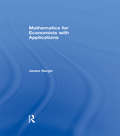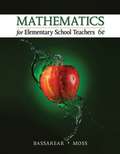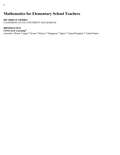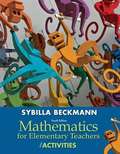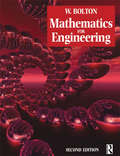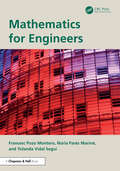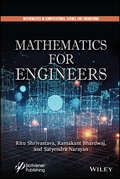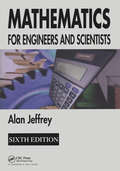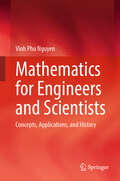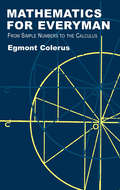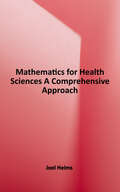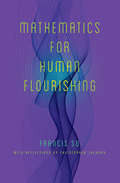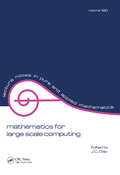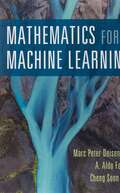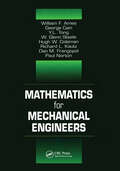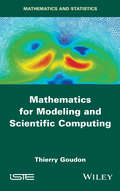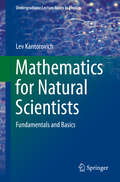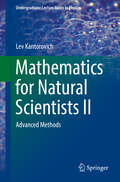- Table View
- List View
Mathematics class 9 - Tamil Nadu Board
by Government Of TamilnaduMathematics Textbook For Class IX has been designed in a way so as to enable students to tackle difficult mathematical problems with ease. Published by SCERT, this book comprehensively covers the curriculum for the board and provides convenient ways of solutions to various numerical problems. The textbook has copious diagrams and solved examples to facilitate easier understanding and better adaptability among students. Unnecessary jargon is kept at bay, making mathematics more interesting for the students. Every topic is supported with abundant solved examples and practice sums to constitute a complete learning experience.
Mathematics for Circuits and Filters
by Wai-Kai ChenEvery engineering professional needs a practical, convenient mathematics resource, without extensive theory and proofs. Mathematics for Circuits and Filters stresses the fundamental theory behind professional applications, making an excellent, flexible resource that enables easy access to the information needed to deal with circuits and filters.The sections feature frequent examples and illustrations, reinforcing the basic theory. The examples also demonstrate applications of the concepts. References at the end of each section are drawn from not only traditional sources, but from relevant, nontraditional ones as well, including software, databases, standards, seminars, and conferences. This leads advanced researchers quickly to the data they may need for more specialized problems.An international panel of experts developed the chapters for practicing engineers, concentrating on the problems that they encounter the most and have the most difficulty with. Mathematics for Circuits and Filters aids in the engineer's understanding and recall of vital mathematical concepts and acts as the engineer's primary resource when looking for solutions to a wide range of problems.
Mathematics for Computer Scientists: A Practice-Oriented Approach
by Peter HartmannThis textbook contains the mathematics needed to study computer science in application-oriented computer science courses. The content is based on the author's many years of teaching experience.The translation of the original German 7th edition Mathematik für Informatiker by Peter Hartmann was done with the help of artificial intelligence. A subsequent human revision was done primarily in terms of content.Textbook FeaturesYou will always find applications to computer science in this book.Not only will you learn mathematical methods, you will gain insights into the ways of mathematical thinking to form a foundation for understanding computer science.Proofs are given when they help you learn something, not for the sake of proving.Mathematics is initially a necessary evil for many students. The author explains in each lesson how students can apply what they have learned by giving many real world examples, and by constantly cross-referencing math and computer science. Students will see how math is not only useful, but can be interesting and sometimes fun.The ContentSets, logic, number theory, algebraic structures, cryptography, vector spaces, matrices, linear equations and mappings, eigenvalues, graph theory.Sequences and series, continuous functions, differential and integral calculus, differential equations, numerics.Probability theory and statistics.The Target AudiencesStudents in all computer science-related coursework, and independent learners.
Mathematics for Digital Science, Volume 1: Fundamentals (ISTE Consignment)
by Gerard-Michel Cochard Mhand HifiOver the past century, advancements in computer science have consistently resulted from extensive mathematical work. Even today, innovations in the digital domain continue to be grounded in a strong mathematical foundation. To succeed in this profession, both today's students and tomorrow’s computer engineers need a solid mathematical background. The goal of this book series is to offer a solid foundation of the knowledge essential to working in the digital sector. Across three volumes, it explores fundamental principles, digital information, data analysis, and optimization. Whether the reader is pursuing initial training or looking to deepen their expertise, the Mathematics for Digital Science series revisits familiar concepts, helping them refresh and expand their knowledge while also introducing equally essential, newer topics.
Mathematics for Digital Science, Volume 2: Digital Information (ISTE Invoiced)
by Mhand Hifi Gérard-Michel CochardOver the past century, advancements in computer science have consistently resulted from extensive mathematical work. Even today, innovations in the digital domain continue to be grounded in a strong mathematical foundation. To succeed in this profession, both today’s students and tomorrow’s computer engineers need a solid mathematical background. The goal of this book series is to offer a solid foundation of the knowledge essential to working in the digital sector. Across three volumes, it explores fundamental principles, digital information, data analysis, and optimization. Whether the reader is pursuing initial training or looking to deepen their expertise, the Mathematics for Digital Science series revisits familiar concepts, helping them refresh and expand their knowledge while also introducing equally essential, newer topics.
Mathematics for Econometrics
by Phoebus J. DhrymesThis book deals with a number of mathematical topics that are of great importance in the study of classical econometrics. There is a lengthy chapter on matrix algebra, which takes the reader from the most elementary aspects to the partitioned inverses, characteristic roots and vectors, symmetric, and orthogonal and positive (semi) definite matrices. The book also covers pseudo-inverses, solutions to systems of linear equations, solutions of vector difference equations with constant coefficients and random forcing functions, matrix differentiation, and permutation matrices. Its novel features include an introduction to asymptotic expansions, and examples of applications to the general-linear model (regression) and the general linear structural econometric model (simultaneous equations).
Mathematics for Economics and Finance: Methods And Modelling
by Martin Anthony Norman BiggsAccessible, concise, and interactive, this book introduces the mathematical methods that are indispensable in economics and finance. Fully updated to be as student friendly as possible, this edition contains extensive problems, worked examples and exercises (with full solutions at the end of the book). Two brand new chapters cover coupled systems of recurrence/differential equations, and matrix diagonalisation. All topics are motivated by problems from economics and finance, demonstrating to students how they can apply the mathematical techniques covered. For undergraduate students of economics, mathematics, or both, this book will be welcomed for its clarity and breadth and the many opportunities it provides for readers to practise and test their understanding.
Mathematics for Economists with Applications
by James BerginMathematics for Economists with Applications provides detailed coverage of the mathematical techniques essential for undergraduate and introductory graduate work in economics, business and finance. Beginning with linear algebra and matrix theory, the book develops the techniques of univariate and multivariate calculus used in economics, proceeding to discuss the theory of optimization in detail. Integration, differential and difference equations are considered in subsequent chapters. Uniquely, the book also features a discussion of statistics and probability, including a study of the key distributions and their role in hypothesis testing. Throughout the text, large numbers of new and insightful examples and an extensive use of graphs explain and motivate the material. Each chapter develops from an elementary level and builds to more advanced topics, providing logical progression for the student, and enabling instructors to prescribe material to the required level of the course. With coverage substantial in depth as well as breadth, and including a companion website at www.routledge.com/cw/bergin, containing exercises related to the worked examples from each chapter of the book, Mathematics for Economists with Applications contains everything needed to understand and apply the mathematical methods and practices fundamental to the study of economics.
Mathematics for Elementary School Teachers
by Meg Moss Tom BassarearIt offers future teachers a comprehensive mathematics course designed to foster concept development through examples, investigations, and explorations. Visual icons throughout the main text allow instructors to easily connect content to the hands-on activities in the corresponding Explorations Manual.
Mathematics for Elementary School Teachers
by Ricardo D. FierroMathematics for Elementary School Teachers is designed to give you a profound understanding of the mathematical content that you are expected to know and be able to teach. The chapters integrate the National Council of Teachers of Mathematics (NCTM) Standards and Expectations and the new Common Core State Standards, as well as research literature. <p><p> The five NCTM Process Standards of problem solving, reasoning and proof, communication, connections, and representation highlight ways that teachers present content, the ways that students learn content, and various ways that students can demonstrate procedural and conceptual understanding. The worked examples and homework questions provide prospective elementary school teachers with opportunities to develop mathematical knowledge, understanding, and skills that they can apply in their own classrooms effectively. <p><p> The learning path begins with the "Where Are We Going?" Chapter Openers, worked Examples with Yellow Markers that indicate the Process Standards throughout the text, to the Concept Maps, to the Section Question Sets with their "refreshers" of Process Standards, to the Chapter Organizers with Learning Outcomes and a list of the corresponding Review Questions, and finally, conclude at the Chapter Tests with their overarching Learning Outcomes.
Mathematics for Elementary Teachers with Activities Fourth Edition
by Sybilla BeckmannAn inquiry-based approach to this course allows future teachers to learn through exploration and group work, leading to a deeper understanding of mathematics. Known for her contributions in math education, Sybilla Beckmann writes the leading text for this approach. In Mathematics for Elementary Teachers with Activities, students engage, explore, discuss, and ultimately reach a true understanding of mathematics. The Fourth Edition provides a new full-color design, making the math come alive. For the first time, the content and activities are combined into the same text, creating a self-contained resource for this course and beyond. Common Core State Standards are integrated to complement the National Council of Teachers of Mathematics.
Mathematics for Engineering (Mathematics For Engineers Ser.)
by W. Bolton W BoltonMathematics for Engineering has been carefully designed to provide a maths course for a wide ability range, and does not go beyond the requirements of Advanced GNVQ. It is an ideal text for any pre-degree engineering course where students require revision of the basics and plenty of practice work. Bill Bolton introduces the key concepts through examples set firmly in engineering contexts, which students will find relevant and motivating. The second edition has been carefully matched to the Curriculum 2000 Advanced GNVQ units:Applied Mathematics in Engineering (compulsory unit 5)Further Mathematics for Engineering (Edexcel option unit 13)Further Applied Mathematics for Engineering (AQA / City & Guilds option unit 25)A new introductory section on number and mensuration has been added, as well as a new section on series and some further material on applications of differentiation and definite integration.Bill Bolton is a leading author of college texts in engineering and other technical subjects. As well as being a lecturer for many years, he has also been Head of Research, Development and Monitoring at BTEC and acted as a consultant for the Further Education Unit.
Mathematics for Engineers
by Francesc Pozo Montero Núria Parés Mariné Yolanda Vidal SeguíMathematics for Engineers offers a comprehensive treatment of the core mathematical topics required for a modern engineering degree. The book begins with an introduction to the basics of mathematical reasoning and builds up the level of complexity as it progresses. The approach of the book is to build understanding through engagement, with numerous exercises and illuminating examples throughout the text designed to foster a practical understanding of the topics under discussion.Features Replete with examples, exercises, and applications Suitable for engineers but also for other students of the quantitative sciences Written in an engaging and accessible style while preserving absolute rigor.
Mathematics for Engineers
by Ramakant Bhardwaj Satyendra Narayan Ritu ShrivastavaMathematics for Engineers serves as a comprehensive guide on the basics of mathematics and their applications in engineering for students and seasoned professionals alike. Mathematics for Engineers is designed to help students develop mathematical proficiencies, which are required in technical courses and careers involving strategic mathematical competence and adaptive reasoning. This volume also acts as a reference for professionals in engineering who need a refresher for their technical math skills. Through this book, students and professionals in the engineering discipline will build a capacity and expand their fundamental mathematical skills for logical thought, reflection, explanation, and justification in the field of applied science. This book is designed for general use for science and engineering students across the globe. The book effectively compiles important information in one place alongside examples and practice problems with application and practice based questions. Emphasis is placed on the application of mathematics in appropriate context and modeling of real-world situations. By the end of this book, students and professionals in the engineering discipline will be able to present and process their mathematical reasoning and conclusions numerically, graphically, symbolically, and verbally.
Mathematics for Engineers and Scientists
by Alan JeffreySince its original publication in 1969, Mathematics for Engineers and Scientists has built a solid foundation in mathematics for legions of undergraduate science and engineering students. It continues to do so, but as the influence of computers has grown and syllabi have evolved, once again the time has come for a new edition.Thoroughly rev
Mathematics for Engineers and Scientists: Concepts, Applications, and History
by Vinh Phu NguyenA majority of mathematics textbooks are written in a rigorous, concise, dry, and boring way. On the other hands, there exist excellent, engaging, fun-to-read popular math books. The problem with these popular books is the lack of mathematics itself. This book is a blend of both. It provides a mathematics book to read, to engage with, and to understand the whys — the story behind the theorems. Written by an engineer, not a mathematician, who struggled to learn math in high school and in university, this book explains in an informal voice the mathematics that future and current engineering and science students need to acquire. If we learn math to understand it, to enjoy it, not to pass a test or an exam, we all learn math better and there is no such a thing that we call math phobia. With a slow pace and this book, everyone can learn math and use it, as the author did at the age of 40 and with a family to take care of.
Mathematics for Everyman: From Simple Numbers to the Calculus
by Egmont ColerusMany people suffer from an inferiority complex where mathematics is concerned, regarding figures and equations with a fear based on bewilderment and inexperience. This book dispels some of the subject's alarming aspects, starting at the very beginning and assuming no mathematical education.Written in a witty and engaging style, the text contains an illustrative example for every point, as well as absorbing glimpses into mathematical history and philosophy. Topics include the system of tens and other number systems; symbols and commands; first steps in algebra and algebraic notation; common fractions and equations; irrational numbers; algebraic functions; analytical geometry; differentials and integrals; the binomial theorem; maxima and minima; logarithms; and much more. Upon reaching the conclusion, readers will possess the fundamentals of mathematical operations, and will undoubtedly appreciate the compelling magic behind a subject they once dreaded.
Mathematics for Health Sciences: A Comprehensive Approach
by Joel HelmsSelect topics according to your mathematical ability and chosen healthcare profession. Begin with a basic math review or move right to deeper concepts, including algebra and geometry, linear equations and graphing, dilutions, solutions, concentrations, dosage calculations, and more! Learn at your own pace with this easy-to-use math text specifically for the health sciences.
Mathematics for Human Flourishing
by Francis SuAn inclusive vision of mathematics—its beauty, its humanity, and its power to build virtues that help us all flourish For mathematician Francis Su, a society without mathematical affection is like a city without concerts, parks, or museums. To miss out on mathematics is to live without experiencing some of humanity&’s most beautiful ideas. In this profound book, written for a wide audience but especially for those disenchanted by their past experiences, an award‑winning mathematician and educator weaves parables, puzzles, and personal reflections to show how mathematics meets basic human desires—such as for play, beauty, freedom, justice, and love—and cultivates virtues essential for human flourishing. These desires and virtues, and the stories told here, reveal how mathematics is intimately tied to being human. Some lessons emerge from those who have struggled, including philosopher Simone Weil, whose own mathematical contributions were overshadowed by her brother&’s, and Christopher Jackson, who discovered mathematics as an inmate in a federal prison. Christopher&’s letters to the author appear throughout the book and show how this intellectual pursuit can—and must—be open to all.
Mathematics for Large Scale Computing (Lecture Notes In Pure And Applied Mathematics Ser.)
by J. C. DíAZDuring recent years a great deal of interest has been devoted to large scale computing applications. This has occurred in great part because of the introduction of advanced high performance computer architectures. The book contains survey articles as well as chapters on specific research applications, development and analysis of numerical algorithms, and performance evaluation of algorithms on advanced architectures. The effect of specialized architectural features on the performance of large scale computation is also considered by several authors. Several areas of applications are represented, including the numerical solution of partial differential equations, iterative techniques for large structured problems, the numerical solution of boundary value problems for ordinary differential equations, numerical optimization, and numerical quadrature. Mathematical issues in computer architecture are also presented, including the description of grey codes for generalized hypercubes. The results presented in this volume give, in our opinion, a representative picture of today’s state of the art in several aspects of large scale computing.
Mathematics for Machine Learning
by Marc Peter Deisenroth A. Aldo Faisal Cheng Soon OngThe fundamental mathematical tools needed to understand machine learning include linear algebra, analytic geometry, matrix decompositions, vector calculus, optimization, probability and statistics. These topics are traditionally taught in disparate courses, making it hard for data science or computer science students, or professionals, to efficiently learn the mathematics. <p><p>This self contained textbook bridges the gap between mathematical and machine learning texts, introducing the mathematical concepts with a minimum of prerequisites. It uses these concepts to derive four central machine learning methods: linear regression, principal component analysis, Gaussian mixture models and support vector machines. For students and others with a mathematical background, these derivations provide a starting point to machine learning texts. <P><p>For those learning the mathematics for the first time, the methods help build intuition and practical experience with applying mathematical concepts. Every chapter includes worked examples and exercises to test understanding. Programming tutorials are offered on the book's web site.
Mathematics for Mechanical Engineers
by Frank Kreith Hugh W. Coleman W. Glenn Steele George Cain Dan M. Frangopol Paul Norton William F. Ames Y. L. Tong Richard L. KautzMathematics for Mechanical Engineers gives mechanical engineers convenient access to the essential problem solving tools that they use each day. It covers applications employed in many different facets of mechanical engineering, from basic through advanced, to ensure that you will easily find answers you need in this handy guide.For the engineer venturing out of familiar territory, the chapters cover fundamentals like physical constants, derivatives, integrals, Fourier transforms, Bessel functions, and Legendre functions. For the experts, it includes thorough sections on the more advanced topics of partial differential equations, approximation methods, and numerical methods, often used in applications. The guide reviews statistics for analyzing engineering data and making inferences, so professionals can extract useful information even with the presence of randomness and uncertainty. The convenient Mathematics for Mechanical Engineers is an indispensable summary of mathematics processes needed by engineers.
Mathematics for Modeling and Scientific Computing
by Thierry GoudonThis book provides the mathematical basis for investigating numerically equations from physics, life sciences or engineering. Tools for analysis and algorithms are confronted to a large set of relevant examples that show the difficulties and the limitations of the most naïve approaches. These examples not only provide the opportunity to put into practice mathematical statements, but modeling issues are also addressed in detail, through the mathematical perspective.
Mathematics for Natural Scientists
by Lev KantorovichThis book covers a course of mathematics designed primarily for physics and engineering students. It includes all the essential material on mathematical methods, presented in a form accessible to physics students, avoiding precise mathematical jargon and proofs which are comprehensible only to mathematicians. Instead, all proofs are given in a form that is clear and convincing enough for a physicist. Examples, where appropriate, are given from physics contexts. Both solved and unsolved problems are provided in each section of the book. Mathematics for Natural Scientists: Fundamentals and Basics is the first of two volumes. Advanced topics and their applications in physics are covered in the second volume.
Mathematics for Natural Scientists II
by Lev KantorovichThis book covers the advanced mathematical techniques useful for physics and engineering students, presented in a form accessible to physics students, avoiding precise mathematical jargon and laborious proofs. Instead, all proofs are given in a simplified form that is clear and convincing for a physicist. Examples, where appropriate, are given from physics contexts. Both solved and unsolved problems are provided in each chapter. Mathematics for Natural Scientists II: Advanced Methods is the second of two volumes. It follows the first volume on Fundamentals and Basics.

